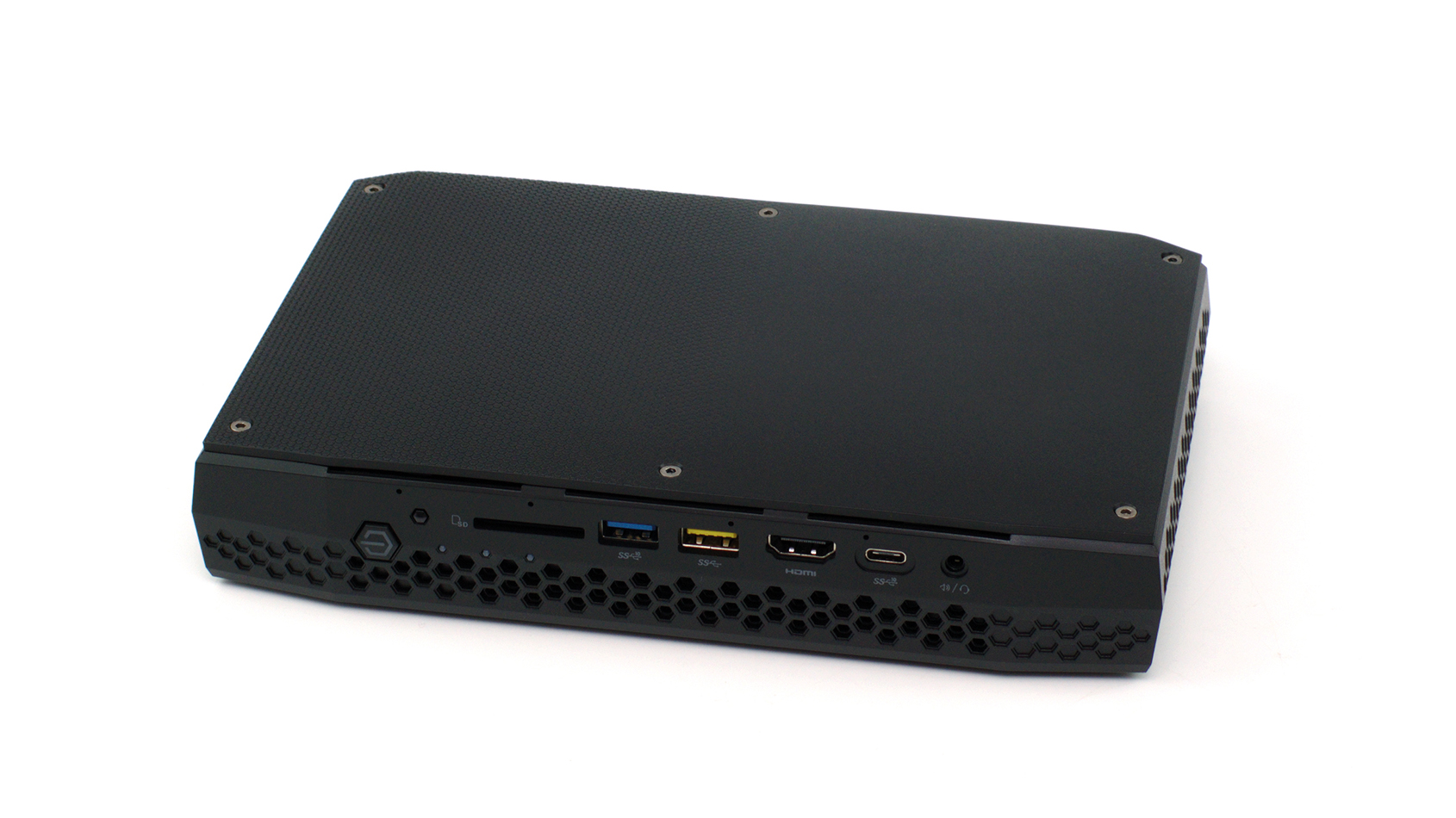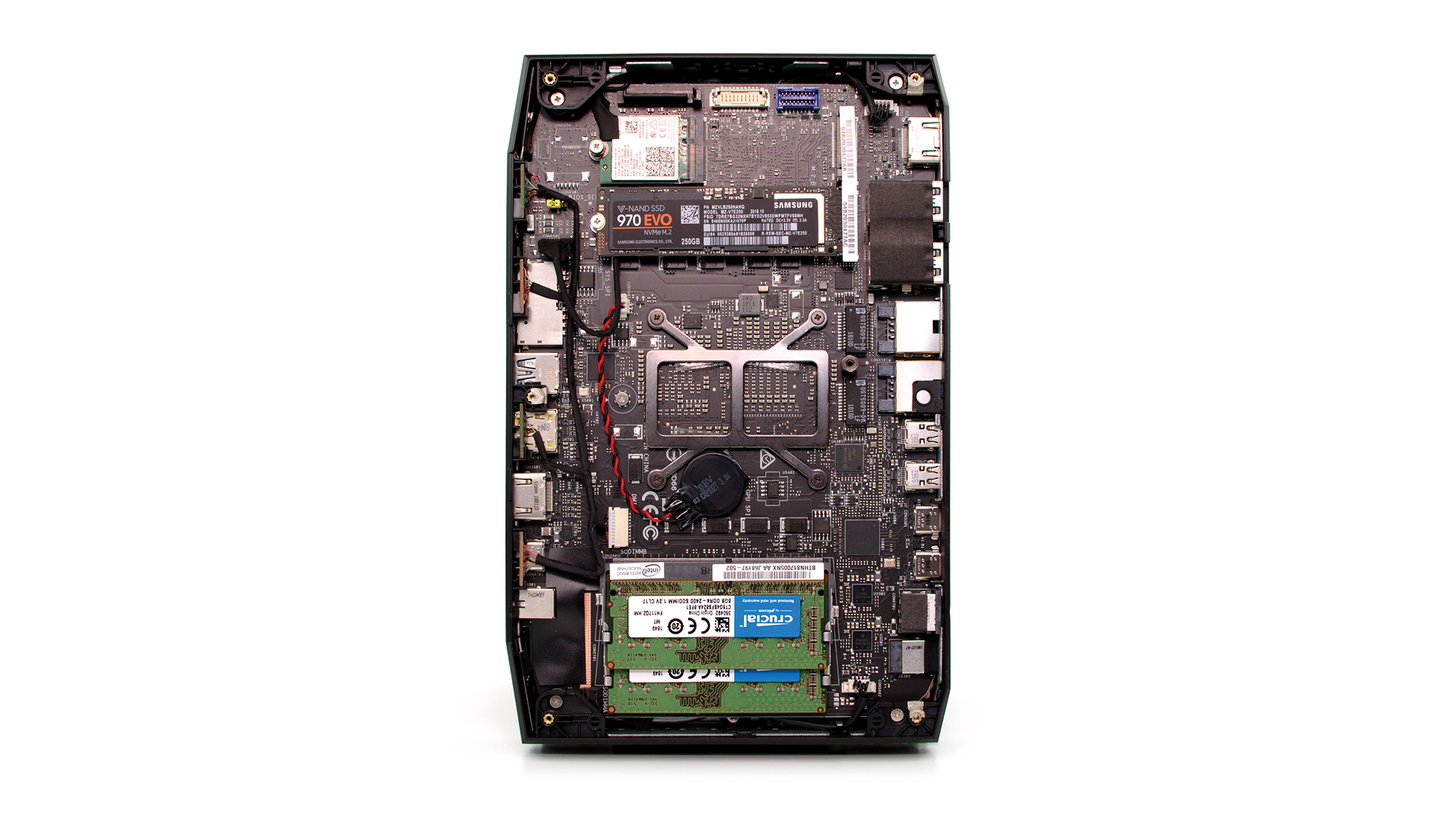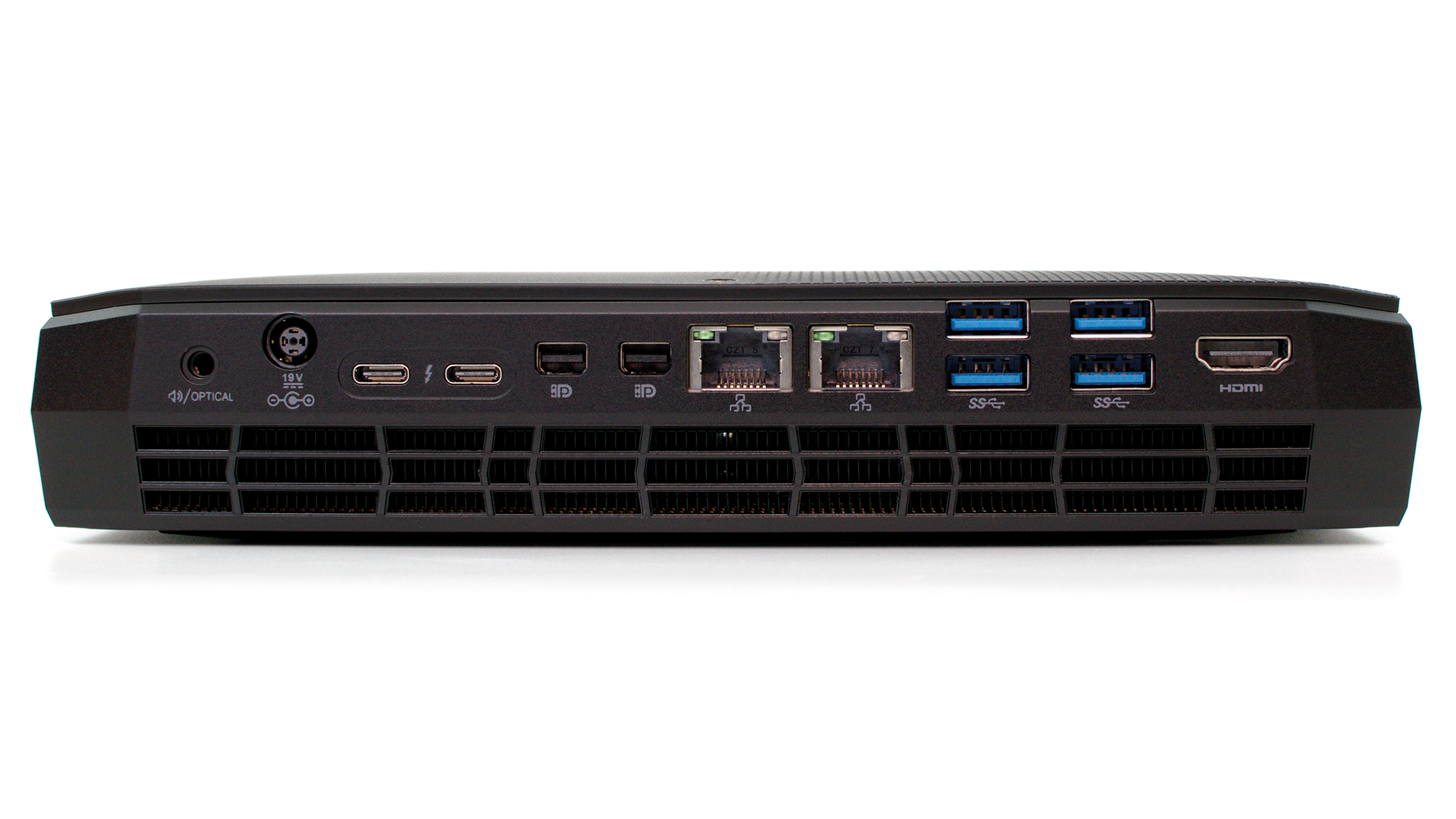Intel Hades Canyon NUC review: Dead impressive
If you don’t mind the weird design, Intel’s Hades Canyon packs a lot of power into a very small space


Intel’s latest NUC device combines an 8th-gen quad-core processor with an AMD Radeon RX Vega GPU, resulting in a device that’s surprisingly capable for a mini PC. The patient may want to hold out for the forthcoming upgrade, but if you just can’t wait, this is a great little machine.
-
+
Tons of connectivity; Great performance; Tacky skull LED can be deactivated
-
-
Supplied without RAM or storage; Comparatively high power consumption; New model possibly coming soon
Intel's line of NUC devices are an interesting breed. Standing for Next Unit of Computing, they're compact, barebones PCs designed partly as a showcase for Intel's latest technology and partly as mini-PCs for personal and business use. They're available both pre-configured or as do-it-yourself kits, and the latest model is one of the meatiest and most fully-featured to date.
Intel Hades Canyon NUC review: Design
Designed as an exercise in cramming as much compute performance into as small a space as possible, the Hades Canyon is barely recognisable as a NUC. The original 4in x 4in square of Intel's Next Unit of Computing motherboard layout is nowhere to be found, replaced instead with a wide angular box adorned with a light-up skull decal that glows blue and pinkish-red when the system is powered on - and which, thankfully, can be switched off.
Weighing in at just over 2KG, it's surprisingly heavy for a mini-PC (especially one with no heatsink) and the 222mm width makes it one of the widest entries in this particular category. The upside to this, of course, is that it has allowed Intel to cram it full of ports - which we'll come to shortly.
Intel Hades Canyon NUC review: Specs and performance
The Hades Canyon might be chunkier than its predecessors, doubly so when you take into account the comparatively large external PSU, but that extra bulk helps it shift: when we added our own 16GB of DDR4-2400 memory and a 250GB NVMe SSD in one of its two M.2 slots, this system actually managed a nearly acceptable frame rate in the Unigine Superposition benchmark at 1080p High settings - although with a 21.2fps average, it wasn't the smoothest of experiences.
The chip at the heart of Intel's Hades Canyon NUC8i7HNK is an odd duck: it combines Intel's four-core, eight-thread Core i5-8705G processor with rival AMD's Radeon RX Vega M GL graphics core, creating something more than the sum of its parts. At least, that was the theory behind the companies' partnership.

The Hades Canyon carried itself well in both our image and video editing tests, as well as the multitasking benchmark. It scored an overall total of 136 - although it still found itself slightly at a loss to Asus's similarly sized PB60, which managed 146 overall. That machine's six cores and 12 threads make it more suitable for heavyweight tasks that will take advantage of multiple threads.
All this does come at the cost of power, though. The Hades Canyon is a very power-hungry system indeed, drawing 125W under load, though idling at a more reasonable 15.5W. The machine also relies on active cooling, which thankfully remains surprisingly quiet - even under sustained load and rising temperatures.
Intel Hades Canyon NUC review: Ports and features
Where the Hades Canyon really excels, though, is its connectivity. Its front panel includes no fewer than three USB ports - one USB-A 3.1 Gen 1, one USB-A 3.1 Gen 2 and a USB-C 3.1 Gen 2 - alongside an analogue headset port, a full-size SD card slot and an HDMI port. This latter port can be used simultaneously alongside the HDMI, two mini-DisplayPort, and two Thunderbolt 3 ports at the rear to drive a total of six independent displays. That's even more than the QuietPC Mini Multi Display PC, which is specifically designed as a digital signage system.
The twin Thunderbolt 3 ports are worth a second look, too. Based on the standard that is set to form the heart of USB 4, the Hades Canyon Thunderbolt 3 ports combine USB 3.1 Gen 2 and DisplayPort connectivity with power delivery and PCI Express lanes on a single cable terminated in a USB-C connector. This also means that the Hades Canyon is fully compatible with external graphics card housings, in case the on-chip Radeon graphics aren't doing the trick, or simply used to add high-speed external storage should you fill up the two M.2 slots.

Those who are a little underwhelmed by the performance of the Hades Canyon do have an alternative option to investigate: its bigger brother, the NUC8i7HVK. Marketed by Intel as being "VR-ready", it switches to a faster Core i7-8809G with Radeon RX Vega M GH graphics processor for improved general-purpose and graphics compute performance, albeit for a 130 premium over the model reviewed. In this context, the front-facing HDMI and USB ports make perfect sense, providing an easy way to connect and disconnect a virtual reality headset without needing to start fiddling around the back of the chassis.
Intel Hades Canyon NUC review: Verdict
It's hard not to be impressed by the Hades Canyon, and it's one of the few ultra-compact designs we've seen that could reasonably replace a full-size desktop for basic graphics tasks. It is, however, starting to look a little long in the tooth - as proven by a bundled software offer where the code expired in January 2019. Consequently, with Intel promising to launch new hardware in Q3 2019, anyone looking at the Hades Canyon may want to hang fire and see what its successor offers - but if you're in a rush to buy now, there's little chance the current-generation model will disappoint.
Verdict
Intel’s latest NUC device combines an 8th-gen quad-core processor with an AMD Radeon RX Vega GPU, resulting in a device that’s surprisingly capable for a mini PC. The patient may want to hold out for the forthcoming upgrade, but if you just can’t wait, this is a great little machine.
| Processor | Intel Core i5-8705G |
| Front USB ports | USB-A 3.1 Gen 1, USB-A 3.1 Gen 2, USB-C 3.1 Gen 2 |
| Rear USB ports | 4 x USB-A 3.1 Gen 1, 2 x Thunderbolt 3 |
| Graphics card | AMD Radeon RX Vega M GL |
| Operating system | Windows 10 Pro |
| Warranty | 3yr RTB |
Get the ITPro daily newsletter
Sign up today and you will receive a free copy of our Future Focus 2025 report - the leading guidance on AI, cybersecurity and other IT challenges as per 700+ senior executives
Gareth Halfacree is an experienced tech journalist and IT professional, and has been writing since 2006. In addition to contributing article for ITPro, Gareth has been featured in publications such as PC Pro, Techmeme, The Register, The MagPi, and Tom’s Hardware.
In addition to his digital articles, Gareth is the author of several best-selling books. These include the Raspberry Pi User Guide, an essential text for those looking to get started with their Raspberry Pi, as well as The Official Raspberry Pi Beginner’s Guide. Gareth also wrote the Official BBC micro:bit User Guide, a comprehensive guide to setting up the pocket-sized computer, learning to code on it, and even creating your own hardware addons.
-
 Women show more team spirit when it comes to cybersecurity, yet they're still missing out on opportunities
Women show more team spirit when it comes to cybersecurity, yet they're still missing out on opportunitiesNews While they're more likely to believe that responsibility should be shared, women are less likely to get the necessary training
By Emma Woollacott Published
-
 OpenAI wants developers using its new GPT-4.1 models – but how do they compare to Claude and Gemini on coding tasks?
OpenAI wants developers using its new GPT-4.1 models – but how do they compare to Claude and Gemini on coding tasks?News OpenAI says its GPT-4.1 model family offers sizable improvements for coding, but tests show competitors still outperform it in key areas.
By Ross Kelly Published
-
 Meta just revived plans to train AI models with European user data – here’s how you can opt out
Meta just revived plans to train AI models with European user data – here’s how you can opt outNews Meta has confirmed plans to train AI models using European users’ public content and conversations with its Meta AI chatbot.
By Nicole Kobie Published

